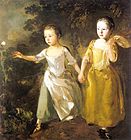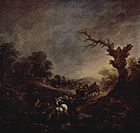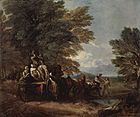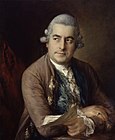Thomas Gainsborough: Difference between revisions
m Reverted edits by 24.180.19.194 (talk) to last revision by Wtmitchell (HG) |
No edit summary |
||
| Line 24: | Line 24: | ||
==Life and work== |
==Life and work== |
||
My name is Jakob |
|||
===Suffolk=== |
===Suffolk=== |
||
Thomas Gainsborough was born in [[Sudbury, Suffolk|Sudbury]], Suffolk, the youngest son of John Gainsborough, a weaver and maker of woolen goods, and the sister of the Reverend Humphry Burroughs.<ref name=NGA>{{cite web |url=http://www.nga.gov/cgi-bin/tbio?person=11650 |title=Thomas Gainsborough |publisher=National Gallery of Art |accessdate=10 December 2011}}</ref> At the age of thirteen he impressed his father with his penciling skills so that he let him go to London to study art in 1740. In London he first trained under engraver [[Hubert Gravelot]]<ref name=NGA/> but eventually became associated with [[William Hogarth]] and his school. He assisted [[Francis Hayman]] in the decoration of the supper boxes at [[Vauxhall Gardens]],<ref name=NGA/> and contributed to the decoration of what is now the [[Thomas Coram Foundation for Children]]. |
Thomas Gainsborough was born in [[Sudbury, Suffolk|Sudbury]], Suffolk, the youngest son of John Gainsborough, a weaver and maker of woolen goods, and the sister of the Reverend Humphry Burroughs.<ref name=NGA>{{cite web |url=http://www.nga.gov/cgi-bin/tbio?person=11650 |title=Thomas Gainsborough |publisher=National Gallery of Art |accessdate=10 December 2011}}</ref> At the age of thirteen he impressed his father with his penciling skills so that he let him go to London to study art in 1740. In London he first trained under engraver [[Hubert Gravelot]]<ref name=NGA/> but eventually became associated with [[William Hogarth]] and his school. He assisted [[Francis Hayman]] in the decoration of the supper boxes at [[Vauxhall Gardens]],<ref name=NGA/> and contributed to the decoration of what is now the [[Thomas Coram Foundation for Children]]. |
||
Revision as of 18:17, 20 December 2012
Thomas Gainsborough | |
|---|---|
 Self-portrait, (1759) | |
| Born | Thomas Gainsborough 14 May 1727 (baptised) |
| Died | 2 August 1788 (aged 61) London, England |
| Nationality | British |
| Known for | Painter |
| Notable work | Mr and Mrs Andrews The Blue Boy |
Thomas Gainsborough (christened 14 May 1727 – 2 August 1788) was an English portrait and landscape painter. He was born the youngest son of John Gainsborough, a weaver in Suffolk, and, in 1740, left home to study art in London with Hubert Gravelot, Francis Hayman, and William Hogarth. In 1746, he married Margaret Burr, and the couple became the parents of two daughters. He moved to Bath in 1759 where fashionable society patronised him, and he began exhibiting in London. In 1769, he became a founding member of the Royal Academy, but his relationship with the organization was thorny and he sometimes withdrew his work from exhibition. Gainsborough moved to London in 1774, and painted portraits of the King and Queen, but the King was obliged to name as royal painter Gainsborough's rival Joshua Reynolds. In his last years, Gainsborough painted relatively simple landscapes and is credited (with Richard Wilson) as the originator of the 18th century British landscape school. Gainsborough died of cancer in 1788 and is interred at St. Anne's Church, Kew, Surrey. He painted quickly and his later pictures are characterised by a light palette and easy strokes. He preferred landscapes to portraits. Cecil Kellaway portrayed Gainsborough in the 1945 film Kitty.
Life and work
My name is Jakob
Suffolk
Thomas Gainsborough was born in Sudbury, Suffolk, the youngest son of John Gainsborough, a weaver and maker of woolen goods, and the sister of the Reverend Humphry Burroughs.[1] At the age of thirteen he impressed his father with his penciling skills so that he let him go to London to study art in 1740. In London he first trained under engraver Hubert Gravelot[1] but eventually became associated with William Hogarth and his school. He assisted Francis Hayman in the decoration of the supper boxes at Vauxhall Gardens,[1] and contributed to the decoration of what is now the Thomas Coram Foundation for Children.
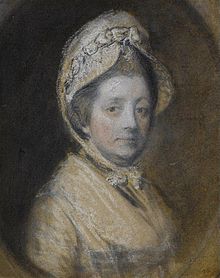
In 1746, Gainsborough married Margaret Burr, an illegitimate daughter of the Duke of Beaufort, who settled a £200 annuity on the couple. The artist's work, then mainly composed of landscape paintings, was not selling very well. He returned to Sudbury in 1748–1749 and concentrated on the painting of portraits.
In 1752, he and his family, now including two daughters, moved to Ipswich. Commissions for personal portraits increased, but his clientele included mainly local merchants and squires. He had to borrow against his wife's annuity.
Bath

In 1759, Gainsborough and his family moved to Bath, living at number 17 The Circus.[2] There, he studied portraits by van Dyck and was eventually able to attract a fashionable clientele. In 1761, he began to send work to the Society of Arts exhibition in London (now the Royal Society of Arts, of which he was one of the earliest members); and from 1769 on, he submitted works to the Royal Academy's annual exhibitions. He selected portraits of well-known or notorious clients in order to attract attention. These exhibitions helped him acquire a national reputation, and he was invited to become one of the founding members of the Royal Academy in 1769. His relationship with the academy, however, was not an easy one and he stopped exhibiting his paintings there in 1773.
London
In 1774, Gainsborough and his family moved to London to live in Schomberg House, Pall Mall.[1][3] In 1777, he again began to exhibit his paintings at the Royal Academy, including portraits of contemporary celebrities, such as the Duke and Duchess of Cumberland. Exhibitions of his work continued for the next six years.

In 1780, he painted the portraits of King George III and his queen and afterwards received many royal commissions. This gave him some influence with the Academy and allowed him to dictate the manner in which he wished his work to be exhibited. However, in 1783, he removed his paintings from the forthcoming exhibition and transferred them to Schomberg House.
In 1784, royal painter Allan Ramsay died and the King was obliged to give the job to Gainsborough's rival and Academy president, Joshua Reynolds. Gainsborough remained the Royal Family's favourite painter, however. At his own express wish, he was buried at St. Anne's Church, Kew, where the Family regularly worshipped.
In his later years, Gainsborough often painted relatively simple, ordinary landscapes. With Richard Wilson, he was one of the originators of the eighteenth-century British landscape school; though simultaneously, in conjunction with Sir Joshua Reynolds, he was the dominant British portraitist of the second half of the 18th century.
He died of cancer on 2 August 1788 at the age of 61 and is interred at St. Anne's Church, Kew, Surrey (located on Kew Green). He is buried next to Francis Bauer, the famous botanical illustrator. As of 2011, an appeal is underway to pay the costs of restoration of his tomb.[4]
Technique

Gainsborough was noted for the speed with which he applied his paint, and he worked more from his observations of nature (and of human nature) than from any application of formal academic rules. The poetic sensibility of his paintings caused Constable to say, "On looking at them, we find tears in our eyes and know not what brings them." He himself said, "I'm sick of portraits, and wish very much to take my viol-da-gam and walk off to some sweet village, where I can paint landskips (sic) and enjoy the fag end of life in quietness and ease." This likeness of landscapes is shown in the way he merged the figures of the portraits with the scenes behind them. His later work was characterised by a light palette and easy, economical strokes.[5]
His most famous works, such as Portrait of Mrs. Graham; Mary and Margaret: The Painter's Daughters; William Hallett and His Wife Elizabeth, nee Stephen, known as The Morning Walk; and Cottage Girl with Dog and Pitcher, display the unique individuality of his subjects.
Gainsborough's only known assistant was his nephew, Gainsborough Dupont.[1] In the last year of his life he collaborated with John Hoppner in painting a full length portrait of Charlotte, Countess Talbot.
In fiction and music
- Kitty (1945) is a notable fictional film about Gainsborough, portrayed by Cecil Kellaway.
- In the song 20th Century Man from the Kinks' 1971 album Muswell Hillbillies, Ray Davies lists Gainsborough as one of the painters he prefers to "your smart modern painters."
Gallery of selected works
-
Colonel John Bullock (c. 1780)
-
Landscape in Suffolk (1748)
-
Mr. and Mrs. Robert Andrews, (c. 1748–1750)
-
Self-Portrait (1754)
-
The Painter`s Daughters Chasing a Butterfly, (1756)
-
Two Daughters with a Cat (c. 1759)
-
Sunset (1760)
-
The Artist`s Daughters, Molly and Peggy (1760)
-
Portrait of the Composer Carl Friedrich Abel with his Viola da Gamba (c. 1765)
-
The Harvest Wagon (c. 1767)
-
Portrait of John Needham, 10th Viscount Kilmorey, (c. 1768), Tate
-
River Landscape (1768–1770)
-
Lady in Blue (c. 1770), Hermitage Museum, Saint Petersburg
-
The Linley Sisters, (1772)
-
Johann Christian Bach, (1776)
-
Gainsborough`s Daughter Mary (1777)
-
The Honorable Richard Savage Nassau de Zuylestein, M.P., (c. 1778–80), oil on canvas, The Detroit Institute of Arts
-
Her Grace Georgiana Cavendish, Duchess of Devonshire (1783), National Gallery of Art
-
The Harvest Wagon (c. 1784)
-
Mrs. Sarah Siddons (1785)
-
Mrs. Richard Brinsley Sheridan (1785–86)
-
Cottage Girl with Dog and pitcher (1785)
-
Self-Portrait (1787)
-
Her Grace Georgiana Cavendish, Duchess of Devonshire, (1787)
See also
- English school of painting
- British art
- List of British painters
- Humphrey Gainsborough
- Holywells Park, Ipswich
- Western painting
Further reading
- Thomas Gainsborough’s 'Lost' Portrait of Auguste Vestri, Martin Postle
- The Letters of Thomas Gainsborough (Paul Mellon Centre for Studies), John Hayes
References
- ^ a b c d e "Thomas Gainsborough". National Gallery of Art. Retrieved 10 December 2011.
- ^ Greenwood, Charles (1977). Famous houses of the West Country. Bath: Kingsmead Press. pp. 84–86. ISBN 978-0-901571-87-8.
- ^ Plaque #2 on Open Plaques
- ^ "Restoration of Thomas Gainsborough's tomb". Richmond Guardian. London. 7 March 2011. Retrieved 1 December 2011.
- ^ Birmingham Museum of Art (2010). Birmingham Museum of Art: A Guide to the Collection. London: Giles. p. 80. ISBN 978-1-904832-77-5. Retrieved 24 June 2011.
External links
- Webmuseum Paris: Thomas Gainsborough
- Victoria and Albert Museum collection
- http://www.abcgallery.com/G/gainsborough/gainsborough.html Olga's Gallery
- www.gac.culture.gov.uk/search/Artist.asp?maker_id=112361
- www.Thomas-Gainsborough.org 70 works by Thomas Gainsborough
- Thomas Gainsborough exhibition catalogs
- Use dmy dates from February 2012
- 1727 births
- 1788 deaths
- People from Sudbury, Suffolk
- English painters
- Royal Academicians
- Portrait artists
- Landscape artists
- Rococo painters
- People associated with the Royal Society of Arts
- Paintings by Thomas Gainsborough
- Cancer deaths in England
- People educated at Sudbury Grammar School





